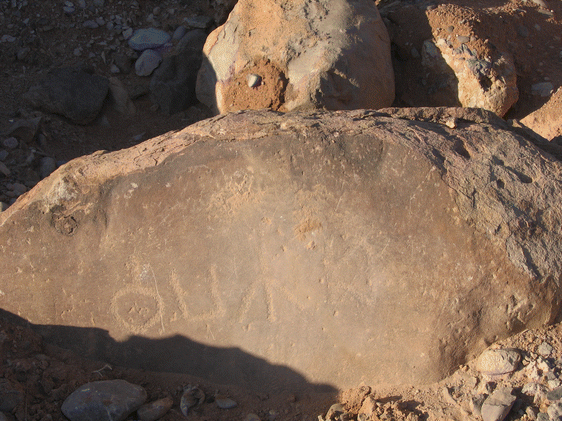https://link.springer.com/article/10.1007/s10437-015-9184-9 
"
The “Puntite” Sites (ca. 2000 BCE–third century CE)
In relation to the discussion of cairn sites, it must be noted that since 2012 in Somaliland, there have been reports of “Pharaonic” or “Puntite sites,” which all seem to be associated with cairns (see Map 2). There is no scope in this article to discuss the Land of Punt, which is located possibly somewhere on the African side of the southern Red Sea Coast, but readers can consult the literature (e.g., Bard and Fattovich 2007; Phillips 1997; Kitchen 1993). I was asked by the Somaliland Government to investigate claims made about the existence of such objects in the summer of 2014. The Ministry of Tourism had been having problems with a man who called himself a Sheikh and claimed to have spirits working with him, digging sites. I let him take me to the sites he found with the help of these spirits (gins). Another man who works with him showed me pictures of the digging, and a film of the two of them and another man, involved with the Ministry, digging such sites. The Sheikh took me to his house in Hargeysa to show me the so-called “Pharaonic” sculptures. He proudly declared that he was selling them for up to US $15000, and named well-known figures as his clientele. The Ministry was worried that due to the demand for illicit antiquities, there might be (re)productions of sculptures. However, the sites were former cairns that had been emptied of their stones. Usually stonecutters who are selling stones to construction companies roam the landscapes for cairn sites, as these are perfectly sized stones for building local houses. I was shown sites with alleged Pharaonic artefacts; these include the twin peaks of Naaso Hablood (“girl’s breasts,” 107), Maxamood Mooge (109), Hargeysa Airport area and Masalaha (108). I have previously climbed the left peak, which has shelters with stone tools. Also, there are underground caves that show ancient habitation in the area between the two peaks. The Land of Punt thus may well be the area of current-day Somalia/Somaliland. However, the current interest has triggered looting activities, as demand has increased from wealthy locals for so-called “Puntite” sculptures. The sculptures and decorated tiles claimed to be of “Puntite” origin must be examined properly along with the sites attributed to them, some of them noted in the maps herein."
Stupid people who are craving money are destroying our history.
"
The “Puntite” Sites (ca. 2000 BCE–third century CE)
In relation to the discussion of cairn sites, it must be noted that since 2012 in Somaliland, there have been reports of “Pharaonic” or “Puntite sites,” which all seem to be associated with cairns (see Map 2). There is no scope in this article to discuss the Land of Punt, which is located possibly somewhere on the African side of the southern Red Sea Coast, but readers can consult the literature (e.g., Bard and Fattovich 2007; Phillips 1997; Kitchen 1993). I was asked by the Somaliland Government to investigate claims made about the existence of such objects in the summer of 2014. The Ministry of Tourism had been having problems with a man who called himself a Sheikh and claimed to have spirits working with him, digging sites. I let him take me to the sites he found with the help of these spirits (gins). Another man who works with him showed me pictures of the digging, and a film of the two of them and another man, involved with the Ministry, digging such sites. The Sheikh took me to his house in Hargeysa to show me the so-called “Pharaonic” sculptures. He proudly declared that he was selling them for up to US $15000, and named well-known figures as his clientele. The Ministry was worried that due to the demand for illicit antiquities, there might be (re)productions of sculptures. However, the sites were former cairns that had been emptied of their stones. Usually stonecutters who are selling stones to construction companies roam the landscapes for cairn sites, as these are perfectly sized stones for building local houses. I was shown sites with alleged Pharaonic artefacts; these include the twin peaks of Naaso Hablood (“girl’s breasts,” 107), Maxamood Mooge (109), Hargeysa Airport area and Masalaha (108). I have previously climbed the left peak, which has shelters with stone tools. Also, there are underground caves that show ancient habitation in the area between the two peaks. The Land of Punt thus may well be the area of current-day Somalia/Somaliland. However, the current interest has triggered looting activities, as demand has increased from wealthy locals for so-called “Puntite” sculptures. The sculptures and decorated tiles claimed to be of “Puntite” origin must be examined properly along with the sites attributed to them, some of them noted in the maps herein."
Stupid people who are craving money are destroying our history.









